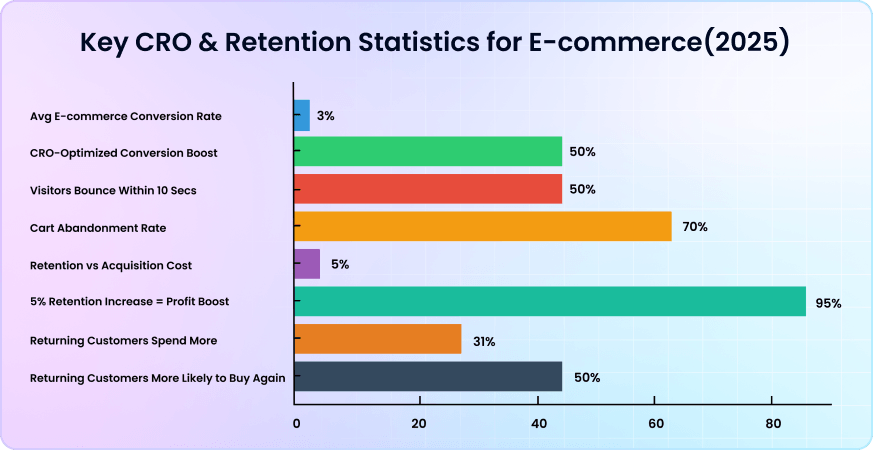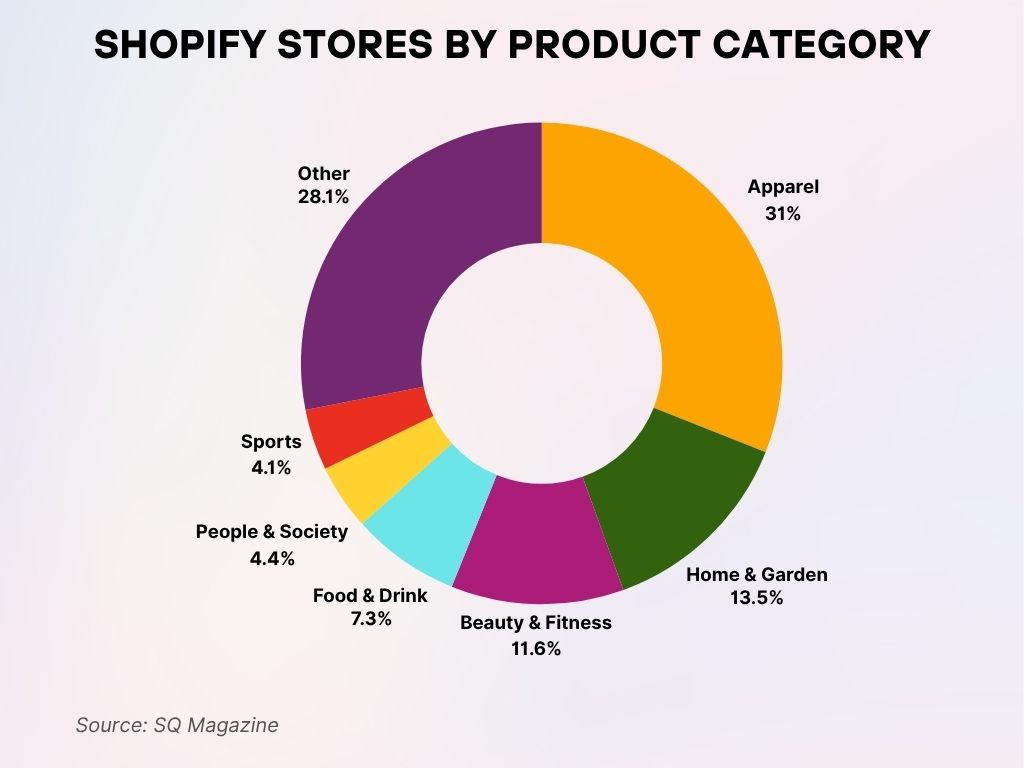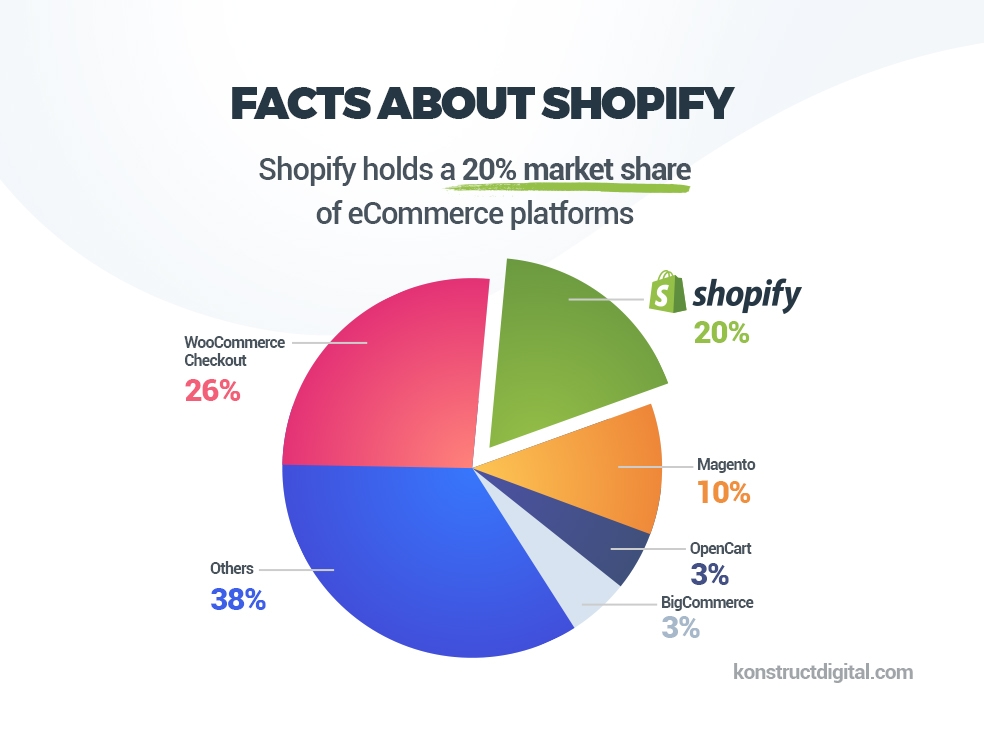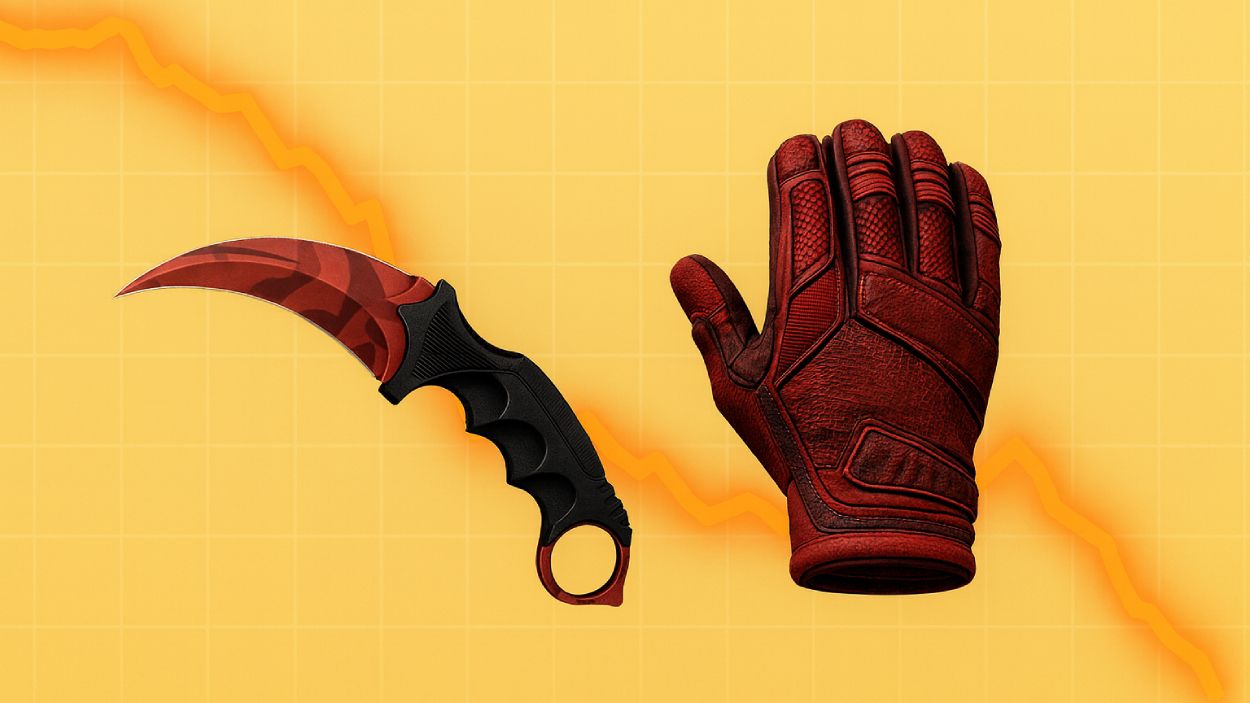When Alex started her handmade candle business during the early pandemic years, she never imagined that within 24 months, she’d be shipping thousands of orders every month, all powered by Shopify. What began as a side hustle on her kitchen counter now thrives online, thanks to an intuitive platform that has enabled millions to turn passion into profit.
In 2025, Shopify continues to shape the global e-commerce landscape by giving entrepreneurs, creators, and enterprises the tools they need to build, scale, and optimize digital storefronts. This article dives deep into the most recent Shopify statistics to uncover how the platform is evolving and impacting the broader e-commerce ecosystem.
Editor’s Choice
- Shopify now powers over 4.8 million live stores globally.
- In 2025, Shopify’s total revenue is expected to exceed $8.6 billion, reflecting a year-over-year growth of nearly 23%.
- The average conversion rate for Shopify stores is 1.75%.
- More than 60% of Shopify traffic in 2025 comes from mobile devices, showing continued growth in mobile-first commerce.
- The Shopify App Store now includes over 9,000 apps, with AI and automation tools among the fastest-growing categories.
- Shopify Plus merchants generate over $1.5 million in average annual revenue, a benchmark significantly higher than standard Shopify users.
- In 2025, over 70% of Shopify merchants are based outside of North America, underlining the platform’s global expansion.
Top Shopify Apps by Install Count
- Product Reviews leads the chart with 531,165 installs, making it the most widely used app on Shopify.
- Geolocation follows closely with 522,859 installs, helping stores auto-detect customer locations.
- Shopify Inbox ranks third with 392,654 installs, streamlining communication with customers directly on store sites.
- Klaviyo: Email Marketing & SMS boasts 294,134 installs, a top choice for marketing automation.
- Judge.me Product Reviews is trusted by 277,524 stores, popular for collecting customer feedback.
- Instafeed – Instagram Feed has 197,258 installs, enabling seamless Instagram integration.
- DSers-AliExpress Dropshipping powers 173,062 stores, supporting efficient dropshipping operations.
- Loox Product Reviews & Photos is used by 163,664 merchants, leveraging visual reviews to boost trust.
- MailChimp: Email Marketing is active on 162,072 stores, a long-standing favorite for email campaigns.
- Printful: Print on Demand closes the list with 146,002 installs, favored for custom product fulfillment.

Total Number of Shopify Stores Worldwide
- As of Q2 2025, there are approximately 4.8 million active Shopify stores worldwide.
- This marks a 17% increase from the 4.1 million reported in mid-2024.
- The United States remains the largest market with over 2 million stores, accounting for more than 40% of total Shopify stores.
- The UK and Australia rank second and third, hosting over 230,000 and 190,000 stores, respectively.
- India has seen the fastest growth, with Shopify stores increasing by over 40% YoY, now surpassing 130,000.
- The number of new Shopify store creations averages 3,500 per day globally in 2025.
- Dropshipping and Print-on-Demand (POD) business models continue to dominate, accounting for roughly 34% of new stores launched.
- Around 12% of Shopify stores in 2025 belong to brick-and-mortar businesses transitioning to hybrid commerce.
- Shopify’s store count in the Latin American market grew 28% year-over-year, led by Brazil and Mexico.
Shopify Revenue and Annual Growth
- Shopify’s total revenue in 2025 is forecasted at $8.6 billion.
- Subscription Solutions contribute roughly 32% of total revenue, with the remainder coming from Merchant Solutions like payments and shipping.
- Shopify Payments usage increased to 76% among eligible merchants, continuing its upward trend.
- The monthly recurring revenue (MRR) surpassed $150 million in Q1 2025.
- Shopify’s gross merchandise volume (GMV) is projected to exceed $260 billion in 2025.
- In the past year, Shopify achieved its first full year of net profitability, with net income reaching over $600 million.
- Revenue from international markets now makes up 46% of total earnings.
- Shopify Capital, the platform’s small business funding arm, disbursed over $5 billion in cumulative loans by early 2025.
- The average merchant loan size through Shopify Capital increased to $32,000 in 2025, reflecting growing trust and higher merchant volumes.
Key CRO & Retention Statistics for E-commerce
- The average e-commerce conversion rate remains low at just 3%, highlighting the need for optimization.
- Implementing CRO strategies can result in a 50% boost in conversions, proving the power of data-driven testing.
- Around 50% of visitors bounce within the first 10 seconds, emphasizing the importance of fast-loading, engaging pages.
- The cart abandonment rate sits high at 70%, showing lost sales opportunities that can be recovered.
- The cost of retention is only 5% compared to customer acquisition, making it significantly more cost-effective.
- A modest 5% increase in customer retention can lead to a 95% profit boost, underlining its immense value.
- Returning customers spend 31% more than new ones, showing the ROI of loyalty.
- 50% of returning customers are more likely to make another purchase, reinforcing the need for retention strategies.

Shopify App Store Usage Statistics
- In 2025, the Shopify App Store houses over 9,000 apps, a 10% increase from the previous year.
- The average store uses 6 to 8 apps, most commonly for marketing, fulfillment, and conversion optimization.
- AI-driven tools for personalization and customer segmentation are among the top 3 most installed app categories.
- Klaviyo, Loox, and ReConvert rank as the top-reviewed apps in their respective categories.
- Subscription-based app installs increased by 21% YoY, led by merchants adopting recurring revenue models.
- Apps related to product bundling and upselling saw a 28% rise in adoption from 2024 to 2025.
- SEO optimization tools remain popular, with over 65% of merchants using at least one SEO-focused app.
- Mobile app builders have grown in popularity, enabling merchants to launch branded apps without custom development.
- The average review rating of apps stands at 4.3 out of 5, and review volume has increased significantly with AI-generated feedback curation.
Mobile vs Desktop Traffic on Shopify Stores
- In 2025, mobile traffic accounts for 63% of all visits to Shopify stores.
- Desktop usage has dropped to 33%, while the remaining 4% comes from tablets and other devices.
- Mobile conversions now make up 54% of total transactions, indicating continued improvement in mobile checkout experiences.
- Stores that optimize their mobile UX see 1.4x higher conversion rates compared to those that don’t.
- Page speed remains a critical factor; sites that load in under 3 seconds on mobile have a bounce rate 28% lower.
- iOS devices account for 58% of mobile traffic, while Android follows at 40%.
- Mobile-first Shopify themes like Dawn and Craft have seen a 70% increase in usage in 2025.
- Voice-assisted search integration on mobile has seen early adoption by around 6% of Shopify stores.
- Mobile cart abandonment rates average 78%, still higher than desktop (63%) despite improvements in UX.
Countries With the Highest Number of Shopify Stores
- The United States dominates Shopify usage with 3,012,321 stores, making it the global leader by a massive margin.
- The United Kingdom ranks second with 212,903 stores, highlighting strong e-commerce adoption.
- Australia follows with 154,625 Shopify stores, showing a thriving digital retail environment.
- Germany hosts 130,285 stores, leading Shopify use in continental Europe.
- Brazil is the top Latin American market with 127,220 stores on Shopify.
- Canada maintains 112,507 stores, contributing to North America’s strong presence on the platform.
- India has rapidly grown to 73,298 stores, reflecting its expanding online business sector.
- France is close behind with 71,928 stores, signaling strong Shopify adoption in Western Europe.
- The Netherlands supports 57,147 Shopify stores, known for its digitally savvy businesses.
- Italy operates 46,211 stores, steadily growing in Shopify’s European user base.
- Japan rounds out the list with 32,018 stores, showing increasing interest in global e-commerce platforms.

Average Order Value on Shopify Stores
- The global average order value (AOV) across Shopify stores in 2025 is $92.75.
- Shopify Plus stores lead with a significantly higher AOV of $214, driven by B2B and high-ticket sales.
- Fashion and accessories stores average around $76 per order, while home goods stores report a higher $135 AOV.
- Bundles and upsells increase average order value by an average of 22% when implemented correctly.
- Stores using AI-powered personalization report an AOV boost of 15%, according to Shopify’s internal data.
- Offering free shipping over a threshold drives higher order totals, with $100+ thresholds yielding the highest lift.
- Stores with loyalty programs and tiered rewards see an average AOV increase of 19% year-over-year.
- Subscription models generate a higher customer lifetime value and an initial AOV of $114 on average.
- A/B testing of pricing structures helped increase AOV by up to 12% in tested Shopify stores.
- Shopify Markets stores (selling internationally) report 7% higher AOVs, attributed to currency localization and tailored offerings.
Shopify’s Share in the E-commerce Platform Market
- In 2025, Shopify holds an estimated 12.6% global market share in the e-commerce platform space.
- In the U.S. market, Shopify continues to trail only behind WooCommerce (21%), holding 17% market share.
- Shopify is the leading e-commerce platform in Canada, with more than 48% of market share.
- Shopify overtook Magento (Adobe Commerce) globally in 2024 and has widened the gap in 2025.
- SaaS-based e-commerce platforms now command over 70% of the market, with Shopify among the top 3.
- Shopify’s market share in Europe has grown to 8.2%, helped by improvements in multi-currency and tax compliance tools.
- In Asia-Pacific, Shopify is the fastest-growing non-native platform, especially in India, Japan, and the Philippines.
- Shopify’s focus on headless commerce and B2B tools has improved its positioning in enterprise discussions.
- The Shopify ecosystem now supports over $600 billion in merchant GMV, a clear sign of its platform depth.
- Over 2 million developers and partners contribute to Shopify’s app, theme, and agency ecosystem, another edge over competitors.
Average Customer Revenue of Shopify Stores
- The average revenue per customer across all Shopify stores is $72, providing a general benchmark.
- The worst-performing 10% of stores earn just $33 per customer, showing the lower end of the spectrum.
- The bottom 20% of stores average $44 per customer, still significantly below the average.
- The top 20% of stores generate $149 per customer, more than double the overall average.
- The top 10% of Shopify stores reach an impressive $226 per customer, over 3x higher than the average.

Shopify Merchant Demographics
- As of 2025, over 52% of Shopify merchants identify as solo entrepreneurs, with no additional staff.
- Around 32% of Shopify store owners are female, with women-led stores growing 15% YoY.
- Millennials (ages 27–42) make up the largest merchant segment, representing 45% of Shopify sellers.
- Gen Z entrepreneurs now represent 14% of all new Shopify stores created in 2025.
- Approximately 21% of merchants operate more than one Shopify store, reflecting increased multi-brand strategies.
- Over 75% of U.S.-based Shopify merchants are small businesses earning under $500K in annual revenue.
- First-generation immigrants make up 12% of Shopify entrepreneurs in North America.
- The most active regions in the U.S. are California, New York, Texas, and Florida, accounting for over 35% of total stores.
- Black-owned businesses on Shopify grew by 19% in the last year, driven by visibility efforts and grant support.
- LGBTQ+-owned Shopify stores represent an estimated 7%, often concentrated in apparel, art, and wellness categories.
Shopify Plus Adoption Rates
- In 2025, Shopify Plus is used by over 38,000 businesses worldwide.
- Shopify Plus merchants account for nearly 26% of total GMV despite being a small portion of total users.
- The average annual revenue of a Shopify Plus store is $1.5M, with high-performing brands exceeding $10M+.
- DTC brands make up over 60% of the Shopify Plus customer base.
- Migration from Magento and custom platforms to Shopify Plus has increased by 22% YoY.
- Popular categories using Plus include fashion, beauty, electronics, and B2B wholesale.
- Built-in enterprise features like customizable checkout, advanced reporting, and APIs drive higher adoption.
- Over 5,000 Shopify Plus merchants use Hydrogen and Oxygen for custom front-end experiences.
- Shopify Plus partners now include over 250 certified agencies, with enterprise services seeing a 31% increase in demand.
- Average onboarding time for Shopify Plus is down to 3–5 weeks, thanks to streamlined migration tools.
Shopify Stores by Product Category
- Apparel dominates the platform, accounting for 31.0% of all Shopify stores, the most popular category.
- Home & Garden is the second-largest segment, representing 13.5% of Shopify stores.
- Beauty & Fitness stores make up 11.6%, reflecting the ongoing demand for health and wellness products.
- Food & Drink holds a 7.3% share, showing the growing trend in online grocery and specialty foods.
- People & Society categories contribute 4.4%, covering blogs, communities, and cause-related shops.
- Sports stores represent 4.1%, tapping into the active lifestyle and gear market.
- The Other category includes 28.1% of stores, encompassing a wide range of niche or mixed product offerings.

Shopify Abandoned Cart Statistics
- The average cart abandonment rate on Shopify is 70.6% as of 2025.
- Mobile abandonment is highest, reaching 78.4%, while desktop holds steadier at 63.2%.
- Shopify merchants who enable abandoned cart emails recover an average of 12% of lost sales.
- Adding exit-intent popups and limited-time offers reduces abandonment by up to 18%.
- Free shipping thresholds are cited as a key factor; carts with added shipping fees see 32% higher abandonment.
- Shopify Flow and Shopify Email are used by 40% of mid-sized merchants to automate recovery sequences.
- Abandoned cart SMS campaigns have an open rate of 88% and click-through rate of 34%.
- Recovery rates are highest when reminders are sent within 30 minutes of abandonment.
- Over 50% of shoppers abandon carts due to payment friction, making payment optimization critical.
- Offering express checkout (Shop Pay, Apple Pay) reduces abandonment by up to 22% on average.
Shopify Store Conversion Rates
- The average conversion rate for Shopify stores in 2025 is 1.75%, a modest increase from 1.6% last year.
- Top-performing stores (top 10%) convert at 3.5% or higher, especially in niche categories.
- Stores offering Buy Now, Pay Later (BNPL) options like Shop Pay Installments see a 12% boost in conversions.
- Mobile-optimized stores report 20% higher conversion rates than those with desktop-only designs.
- Using video on product pages improves conversion rates by an average of 9%.
- Product reviews and UGC increase purchase likelihood by up to 22%, especially for first-time visitors.
- Stores with chatbot or live chat enabled convert at 2.1% on average, vs. 1.6% without.
- One-click upsell tools boost post-checkout conversions by up to 15%.
- A/B testing campaigns show an average conversion lift of 11% when implemented properly.
- Conversion rates for email-referred traffic (3.3%) are nearly double that of paid ads (1.7%).
Shopify Market Share Among E-commerce Platforms
- Shopify holds a 20% market share, making it one of the top eCommerce platforms globally.
- WooCommerce Checkout leads with a 26% share, surpassing Shopify in user base.
- Magento maintains a 10% market share, popular among enterprise-level stores.
- BigCommerce and OpenCart each capture 3%, showing niche but steady usage.
- Other platforms make up the remaining 38%, highlighting a highly fragmented e-commerce landscape.

Impact of Shopify on Small and Medium Businesses
- In 2025, Shopify supports over 2.9 million small businesses globally, across 175 countries.
- 98% of all Shopify merchants qualify as SMBs, with fewer than 10 employees.
- Shopify claims to have contributed over $510 billion to global economic activity since its launch.
- 40% of merchants report that Shopify enabled them to start a business with under $1,000 in startup costs.
- Around 22% of U.S. SMBs on Shopify were founded during the pandemic and continue to operate profitably.
- Shopify’s tools for international selling helped 45% of SMBs expand globally in the last two years.
- Shopify Capital loans have supported over 800,000 businesses, 80% of which are small operations.
- Merchants who adopt Shopify’s POS system report a 17% increase in blended sales (online + retail).
- Over 50,000 SMBs joined Shopify’s partner program in 2025 as developers, designers, and consultants.
- Shopify’s integrations with platforms like TikTok, Instagram, and YouTube Shopping helped boost SMB reach by 27% on average.
Recent Developments and Updates
- In early 2025, Shopify launched Shopify Sidekick, an AI assistant for store management and analytics.
- Shopify released new B2B features, including customer-specific pricing and purchase order management.
- The Shopify Magic suite now includes AI-generated product descriptions, email campaigns, and FAQs.
- Shopify Markets Pro expanded into 10 new countries, offering built-in tax, duties, and translation support.
- New integrations with Amazon Buy with Prime allow Shopify merchants to offer faster delivery options in the U.S.
- Shopify introduced a native bundling feature, eliminating reliance on third-party apps.
- Shopify Collective expanded, allowing merchants to sell products from verified suppliers directly through their dashboards.
- Hydrogen (Shopify’s React framework) and Oxygen (their hosting platform) were updated with faster rendering and edge deployment.
- In Q1 2025, Shopify rolled out carbon tracking tools, helping merchants disclose emissions per order.
- Shopify’s API limits were raised to support enterprise scaling, reducing throttling for larger stores.
Conclusion
Shopify’s evolution in 2025 paints a clear picture: it’s no longer just a platform; it’s an infrastructure for global commerce. From small artists launching side hustles to enterprise-grade brands scaling internationally, Shopify has become a foundational tool for modern retail. Backed by data-driven innovation, AI integrations, and a growing partner ecosystem, the platform continues to empower merchants to build, optimize, and expand their businesses on their terms.


































































